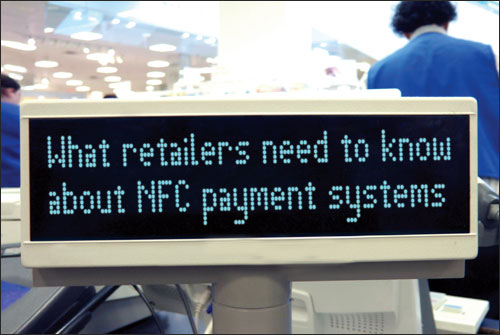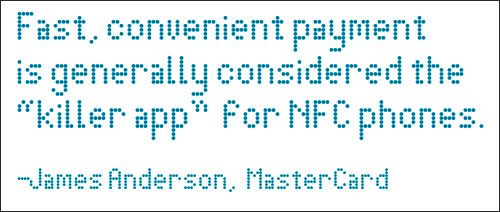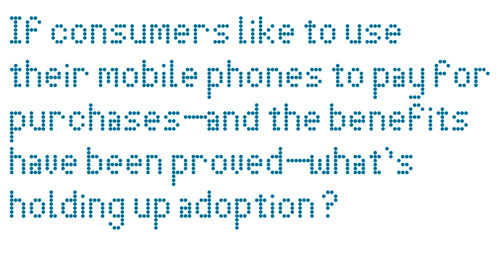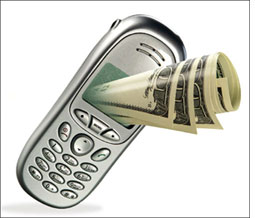Five years ago, RFID-enabled credit cards, issued by American Express, MasterCard and Visa, promised to transform consumers’ spending habits and open new opportunities for retailers. To make a purchase, shoppers would just need to wave an RFID credit card by an in-store RFID interrogator. These contactless payments—especially for high-volume, typically cash purchases such as fast food, movie tickets and gasoline—would streamline the checkout process, improving customer satisfaction, and increase sales by enabling businesses to serve more people during peak periods.
But consumers and retailers, particularly in the United States, haven’t embraced contactless payments for retail purchases (contactless payments for transit systems are popular in Asia and Europe). One reason: The financial institutions that issue RFID credit cards haven’t promoted them sufficiently. Another: Many retailers that adopted contactless payment systems haven’t offered consumers incentives to use RFID cards or trained their clerks to manage contactless transactions.
vAs a result, most retailers that invested in contactless equipment haven’t seen a return on their investment. And retailers that need to replace aging point-of-sale (POS) systems, for Payment Card Industry (PCI) security compliance or other reasons, want to know what to expect in terms of ROI before they take the plunge.
Here’s why it makes sense to invest in a contactless payment solution—and why retailers that have already bought in will soon be able to put their systems to more use: The next-generation contactless payment platform is the mobile phone. While people often leave home without cash or credit cards, they rarely venture out without their phones, which they rely on for everything from talking and texting to gaming and Web surfing. And numerous studies have found that consumers also like to use their mobile phones to make cash payments.
A pilot conducted by Citibank in Bangalore, India, for example, revealed that consumers use their mobile phones to pay for purchases at a higher rate than consumers using conventional credit cards. The Citi Tap and Pay project, launched in June 2009 and slated for completion in early 2010, involved approximately 3,000 consumers and 250 merchants.
What allows consumers to make instant payments with their mobile phones is Near-Field Communication (NFC)—a short-range, high-frequency (13.56 MHz) wireless technology that enables data exchange between two NFC devices over a distance of several centimeters. And the NFC protocol is compatible with the millions of contactless payment readers already in place worldwide.
In addition, NFC phones can deliver more tangible benefits than RFID credit cards to both consumers and retailers. Lingering issues must be resolved before NFC can be integrated into mobile phones—probably in 2011, “with more robust types of commercial rollouts in 2012,” says Randy Vanderhoof, executive director of the Smart Card Alliance.
So now is the time for retailers to get up to speed on contactless payment solutions. “Clearly, contactless is of the size and interest that if you’re not looking at it, you’re probably being a little remiss, especially given the life span of POS systems,” says Jonathan Collins, principal analyst of ABI Research‘s RFID and contactless group.
Phoning in Benefits
Fast, convenient payment is generally considered the “killer app” for NFC phones, says James Anderson, a member of the NFC Forum board of directors and VP of mobile product development for MasterCard. But industry observers cite several other potential benefits for both consumers and retailers.
Promotions. NFC phones could personalize the shopping experience. A shopper, for example, could enter a store, tap her NFC phone on a smart poster that has an embedded NFC tag and receive on her phone a message with a customized offer—”Get 20 percent off glassware to go with the dishes you bought last week!”—based on her customer loyalty program profile and recent shopping activity. She could then redeem that offer at checkout by holding the NFC phone up to the payment device.
Today, the maximum redemption rate for coupons, which consumers typically receive at checkout or via direct mail, is just 1 percent—more typically .5 percent—because coupons aren’t well personalized and consumers tend to leave them at home. Mobile-based promotions, on the other hand, yield “a 15 to 50 percent redemption rate,” says Mohammad Khan, president and founder of contactless payment solutions vendor ViVOtech. “That’s quite a large difference, and the reason is that what I am getting as a consumer is personalized based on who I am, and I could get it at the time when I am in the mode of purchase.”
Loyalty programs. Retailers could generate repeat customers by making it easier for shoppers to redeem the points they’ve accumulated over time as part of loyalty programs. “You can have a whole loyalty program that is managed in cell phones, so consumers know how many points they have for a store,” says Jean-Louis Carrara, VP of business development for telecommunications at Gemalto North America, a digital security vendor. “And they’ll redeem them more often via [NFC-enabled] cell phones.”
Click here to view a larger version of the image.
Product information. “There’s only so much information you can put on the shelf about a product,” says MasterCard’s Anderson. But merchants post volumes of data about their offerings on their Web sites, and NFC can bridge the gap, enabling shoppers to view that data while they’re in purchase mode at the store. Merchandisers could place an NFC tag on a shelf or in a display, and alert consumers to tap it with their phones to access a mobile-optimized Web site for more information and downloadable offers affiliated with the product, or even to place an order if the item is not on the shelf in the desired size or color. “The information asset they have available can be leveraged better in the store than it can be today,” Anderson says. It’s not cost-prohibitive, he adds, because you’re not tagging specific boxes or even pallets, just shelves or locations near them.
New customers. Retailers could work with mobile network operators to reach out to potential customers and drive traffic to their stores. A retailer, for example, could contract with AT&T or another service provider to send text messages to people who use the operator’s NFC phones, entitling them to a 20 percent discount on purchases when they log in with their NFC phones from the store on a specific day.
Social networking. NFC phones could also leverage social networks to draw more consumers to bars, restaurants and other venues. “I’ve heard of some interesting models using NFC technology where you could come into a bar, tap a phone to a target on a ‘registry wall’ and that automatically sends a message to all your social networks that you’re at Joe’s Bar and Grill so come visit,” says the Smart Card Alliance’s Vanderhoof. “Having the ability to pass some personal information about myself to a service provider simply by holding my phone to a target on the wall, and having the service provider send that information out broadly, might be an appealing use of the technology.”
Talking to NFC Phones
Retailers that have already invested in contactless payment systems for use with RFID credit cards are set to accept payments from NFC phones. “We have 75 million contactless payment cards issued in the U.S., 150,000 merchants and 400,000 payment terminals,” Vanderhoof says, “so we have a fairly broad base of contactless payments infrastructure that NFC will leverage when NFC handsets hit the market.” While there are more NFC mobile phone trials being conducted in Asia and Europe, he adds, fewer retailers on those continents have NFC payment terminals.
NFC phones support card emulation mode, which is what allows them to interact with contactless payment systems, explains MasterCard’s Anderson. “It’s critical to understand that all the investments merchants have made installing terminals that accept PayPass and other contactless payments will carry through with NFC phones,” he says.
Retailers aiming to upgrade their POS systems to support contactless payments must replace devices that accept only magnetic stripe swipes. The new devices support RFID credit card and NFC phone payments, as well as mag-stripe cards. ViVOtech’s system also includes software that enables merchants to create, manage and deliver personalized and context-sensitive information—including coupons, promotions and rewards—to consumers’ mobile phones.
Once the new hardware is installed, the software must be tweaked to ensure that data from the contactless cards—and NFC phones—is routed appropriately through the payment networks. “It’s a minor software change on the back end that allows the terminal to accept this new format data that comes through the card or NFC phone, and then everything else operates the way it currently does,” Vanderhoof says. “The card data is routed to the payment network to authorize validity, it comes back with authorization, the transaction is completed and payment data is sent through the network of settlements.”
Retailers that need to replace their POS systems but aren’t convinced NFC phones will take off can buy upgradable terminals available from several vendors. VeriFone, for instance, offers a modular approach, allowing retailers to buy its POS systems without onboard contactless support and add the contactless modules later. “I think it’s likely to be baby steps in terms of how NFC plays out,” says Erik Vlugt, VP of product marketing at VeriFone. This strategy, he says, keeps customers ahead of technology while giving those who need flexibility the option to buy what they want when they want it.
“Upgrading to contactless is not so much an issue on the hardware side,” says ABI’s Collins. But, he notes, built-in contactless capability may bring advantages in terms of tighter integration and form factor, such as saving valuable counter space. “These things need to be close enough to customers so they can put their card toward it,” he says. “And often add-ons take up counter space, which could otherwise be used for ad hoc purchase offers.”
NFC Phones on Hold
So, if consumers like to use their mobile phones to pay for purchases—and the benefits of NFC payment solutions have been proved—what’s holding up widespread adoption? In a word: money. Numerous players are involved—handset makers, mobile network operators, credit card issuers and payment processors—and everyone wants a piece of the pie. They’ve been struggling for several years now to find a workable business model.
“There’s clear consumer interest,” Vanderhoof says. “But we have yet to break through all the necessary positioning between the payments industry, the mobile operators and the handset manufacturers to come together and agree on a strategy for how this technology moves into the market.”
Anderson is confident the breakthroughs are beginning. “I think the parties who’ve had to cooperate have been circling each other for awhile, and we’re starting to see some coming together,” he says, citing last year’s deal between mobile operator Orange UK and credit card vendor Barclaycard as an example.
Announcing a strategic partnership to develop NFC-based mobile contactless services, the companies said last year their technology “will enable market-leading mobile alerts, servicing capabilities and new banking applications, all of which will help customers keep in control of their finances while on the move.” Their goal: widespread adoption of mobile contactless technology by 2012.
Is It Safe to Shop With My NFC Phone?
Contactless payments with NFC mobile phones may be fast and convenient, but if consumers don’t trust the wireless technology with their money, retailers won’t see the broad adoption they need to get a return on their investment in NFC payment systems. It’s not unusual for consumers to consider security when presented with new payment options, says James Anderson, a member of the NFC Forum board of directors and VP of mobile product development for MasterCard.
“When you talk about money, they ask about security,” Anderson says. “But we have had no problems in pilots and trials in getting people to a place where they are comfortable with the service and using it.”
MasterCard says it instills confidence, in part, by explaining the security features built into its PayPass contactless protocol. There is a short read range between the phone and the interrogator, which makes it difficult to surreptitiously read the data being transmitted. But if a thief were to capture the transaction data, which is encrypted, the data would be useless. That’s because it includes a random number that changes with each transaction. Any attempt to perform a transaction with a random number that has already been used would be rejected. The company also reminds consumers of the standard protections that come with any MasterCard account.
It’s likely that consumers will need to enter a password before they make a payment, and that could make NFC phones a more secure payment vehicle than conventional credit cards, says Jean-Louis Carrara, VP of business development for telecommunications at Gemalto North America, a digital security vendor. “If you lost your phone and there’s a payment application on there, it would probably require a PIN to access it,” he says, “as opposed to a card that could be used without a PIN.”
The NFC Forum, which has a Security Technical Working Group charged with protecting consumer identity and privacy, says transactions are secure with the payment application usually protected by a password. And as with lost credit cards, consumers can report lost NFC phones and have their accounts blocked, preventing authorization of further transactions.






